Header logo
header top contact widget
Dental Fears
Dental Fear Can Be Detrimental To More Than Your Smile
Posted on Feb 15, 2024 by William J. Claiborne, DDS MS
There are varying figures on the prevalence of dental fear in the U.S. However, there is no argument that it exists and affects a rather substantial number of adults.
A 2018 study shared by Dental Products Report listed the results of a study of things that keep adults from going to the dentist. Over 60% of the 18,000 polled admitted to having dental fear. Four percent shared they had never gone to a dentist as a result.
https://www.dentalproductsreport.com/view/study-finds-more-60-percent-people-suffer-dental-fear
Another study by the Cleveland Clinic stated that about 36% of people in the U.S. have a fear of dental treatment, with 12% having an extreme fear (known as “dental phobia”).
While traumatic experiences in the past (often as a child) cause some people to be fearful of dental visits, others are not aware of why or how their fears began.
The Cleveland Clinic cites the top reasons that cause people to avoid or delay dental care are:
• Fear that the anesthetic won’t be sufficient or fear of the side effects (such as numb lips) after treatment
• Fear of bleeding during a dental procedure
• Fear gagging, choking or not being able to breathe or swallow during treatment
• Fear of dentist (often due to a bad experience in the past)
• Fear of pain
• Fear of needles
• The noise made by drills or other instruments used by the dentist or hygienist
• The smells of antiseptics or other chemicals used in a dental office
https://my.clevelandclinic.org/health/diseases/22594-dentophobia-fear-of-dentists
Having the jitters at the dental office is not all that difficult to understand. During these visits, patients are positioned on their backs on a narrow recliner with a bright light shining in their faces. Add to that having to maintain an open mouth (which is full of sensitive nerves) without really knowing what is being done. It’s not surprising that there are some uneasy feelings.
Fear or anxiety are normal reactions of the brain’s “fight or flight” response. For instance, some people have an intense fear of spiders or heights. Their reactions are automatic. Yet, in many cases of dental fear, some learn to override these reactions once they develop a sense of trust in being treated gently and respectfully.
In addition to avoiding care due to fear, some of the oral health problems we see occur from:
– Insufficient oral hygiene
– Avoiding regular dental check-ups and cleanings
– Ignoring symptoms of gum disease, such as seeing blood in the sink when brushing
– Brushing too rigorously or using abrasive substances to brush
– Age-related problems, such as oral dryness
– Oral dryness due to snoring or sinus problems
– Eating a high-carb diet or snacking frequently
– Smoking (including cigarettes, vaping, marijuana, and chew)
– Regular alcohol consumption
Certainly, some people are merely more susceptible to dental decay and bacterial buildup in the mouth. It can be due to genetics or some illnesses and diseases. Yet, the majority of reasons for having oral problems can be dealt with through proper at-home care and having regular dental exams.
When dental care is delayed or avoided due to fear, small problems that could have been prevented (or easily resolved) become big problems. Big problems require more extensive procedures, more expense and more time in treatment. When dental needs become more significant, fearful patients are actually adding to their reasons to dread the dentist.
Too, when regular dental check-ups and cleanings are avoided, the result can lead to periodontal (gum) disease, which is the nation’s leading cause of adult tooth loss. Periodontal disease occurs when an over-accumulation of oral bacteria become infectious. As it penetrates gum tissues, it also attacks the bone structures underneath the gums. This disease requires treatment that is more extensive.
Additionally, tooth loss can create an entirely new set of procedural needs and costs.
For the individual who has high anxiety or fear associated with dental visits, how are they supposed to set aside these obstacles in order to receive the dental care they need? Obviously, problems in the mouth can easily exacerbate when the signs and symptoms of gum disease are back-burnered.
At our Asheville periodontal dental office, we believe that an informed patient is a healthier patient. Understanding what the problems are and what we are doing to attend to them often helps to keep the patient involved with their oral health. It also tends to help the patient relax.
As a periodontist, I feel it’s important for every adult to know the signs and symptoms of gum disease:
Gums that bleed easily
Red, swollen, tender gums
Persistent bad breath
Gums that pull away from the teeth (recede)
Changes in the way teeth fit together when biting
Changes in the fit of partial dentures
Permanent teeth that loosen or separate
When any of these emerge, prompt treatment can minimize treatment time and costs. However, ignoring the warning signs merely allows the disease to progress further – requiring more time in treatment and greater expense.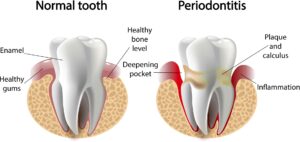
In addition to the related problems of cavities, bad breath and tooth loss, the inflammatory bacteria of gum disease can impact overall health. Years of studies have found frightening correlations between oral bacteria and the worsening or development of serious diseases.
Research has found that the oral bacteria of gum disease (which affects over 47% of the nation’s adult population) can enter the bloodstream. Once bloodborne, this bacteria has been found to trigger inflammation that has been associated with a wide range of serious health problems. Research has shown links between these infectious bacteria to heart disease, stroke, diabetes, arthritis, some cancers, preterm babies, erectile dysfunction (ED) and even Alzheimer’s disease.
I am very proud of the relationship of trust my team and I have with our patients. They know our goal is to never cause them discomfort. Although we cannot always guarantee they’ll have no discomfort at all, we take extra steps to provide optimal comfort at every visit.
In addition to this commitment, we offer oral sedation and I.V. sedation (also referred to as “twilight sleep”).
Oral sedation is a pill that helps patients relax. It also has an amnesiac effect, leaving most with little or no memory of treatment afterward. I.V. sedation places the patient in a deeper sleep state, also erasing memory of the procedure. It is administered by a doctor of anesthesiology, overseen by Dr. Brad Stone, a Medical Doctor (MD) and a board certified Anesthesiologist & Pediatric Anesthesiologist.
https://www.biltmoreperiodontics.com/comprehensive-care-team/
With both sedation options, patients are closely monitored with advanced safety equipment throughout treatment.
If fear has prevented you from a healthy smile, schedule a consultation in our Western NC periodontal dental office. During this time, we can discuss comfort options that may be best for your individual needs. Call 828-274-9440.
Do Different Age Groups Perceive the Importance of Oral Health Differently?
Posted on Feb 09, 2024 by William J. Claiborne, DDS MS
Just how important is your oral health?
Although Americans often focus on their smiles esthetically, it’s a far more important part of you than is often given due credit on a day-to-day basis. Yes, straight, white teeth help to enhance the appearance of a smile (as well as facial appearance), it’s what is typically not seen that has far greater importance.
About 50% of the world’s population over the age of 30 suffer from periodontitis. In the U.S., a developed country with excellent healthcare, a whopping 47% of adults over the age of 30 have some level of periodontal disease.
Because gum disease can begin without obvious symptoms, or be present without having pain, it is too easily ignored. This allows the disease to progress further.
The early stage, known as gingivitis, usually begins with swollen and tender gums that bleed easily when brushing teeth. As it worsens, the healthy pink hue of gums darken to more of a red color and breath odor is persistently bad. The gums begin to loosen their strong grip around the base of teeth, allowing infectious bacteria to reach bone structures that support tooth roots. In advanced stages (periodontitis), pus pockets form near the base of some teeth and gums become spongy in texture.
The bacteria of periodontal disease doesn’t just damage oral health. Through weakened oral tissues, the bacteria can enter the bloodstream and trigger inflammatory reactions. These reactions can worsen some serious health conditions and even activate others.
Research has found correlations between these bacteria and heart disease, stroke, diabetes, arthritis, some cancers (including pancreatic), preterm babies, erectile dysfunction, and Alzheimer’s disease.
In a 2020 study, individuals with gum disease who contracted COVID-19 were 9 times more likely to die. And, the study showed that COVID patients who already had advanced gum disease were 3 times more likely to end up in intensive care or on a ventilator. Evidence shows that poor oral health can increase viral infection severity, and even fatality rates.
But, does age play a part in the commitment to oral health?
A report commissioned by Delta Dental Plans Association revealed some concerning information regarding age groups and perceptions of oral health. With over 1,000 online participants, 87% listed their priority for maintaining proper oral care was to save money or avoid unexpected expenses. Two-thirds of the group listed their commitment to at-home dental hygiene as the desire to avoid tooth decay and gum disease. Yet, only 79% of adults stated they brushed their teeth twice a day with only 33% admitting to flossing daily.
In reviewing age groups, the report found that baby boomers (those born between 1946 – 1964) understand there is a strong link between their oral and overall health, but are less aware than other generations about the connection between poor dental health and chronic diseases (such as arthritis and diabetes). Those listed in the Generation Z group (born between 1997 – 2012) showed less commitment to their oral health as the “boomers,” but are more focused on eco-friendly and nontraditional oral care products. Only 76% of Generation Z agreed that oral health is closely connected to overall health.
An article in RDH Today recently shared that one-third of millennials (born between 1981 and 1996) admit to only brushing once per day, and the average millennial has gone over two days without brushing at all. Yet, 28% of young adults admit that ““The appearance of my mouth and teeth affects my ability to interview for a job.”
The study also shared that 27% of millennials are uncomfortable going to the dentist compared to 23% of respondents 55 years and older, and 56% of millennials have simply made an excuse not to go to the dentist compared to the 36% of those 55 years and older.
While fear remains a factor in a percentage of adults, this deterrent has existed for years among all ages. The American Dental Association conducted a survey on millennials, the fear issue was not the leading problem. Cost and inconvenient time and location were cited as the top excuses for avoiding regular dental care.
Excuses aside, here are some reminders about the benefits of maintaining good oral health:
• Technology – Today’s imaging technology (such as our Cone Beam technology and IntraOral scanners), allow us to treatment plan for the most conservative treatment possible. These amazing features provide amazing detail so treatment can be performed with precision for optimal outcomes.
• Comfort – In addition to the conservative treatment made possible by advanced imaging technology, we offer enhanced comfort options, including oral and I.V. sedation. Also referred to as “twilight sleep” or “sleep dentistry,” these sedatives are administered by a doctor of anesthesia who utilizes advanced safety monitoring equipment.
• Savings of Time & Money – The reason for 6-month dental check-ups and dental cleanings is to remove tartar buildup before damage can occur. Your hygienist and dentist can look for signs of gum disease so measures can be taken before the disease explodes into the need for more costly treatment to resolve the problem. Since gum disease is the nation’s leading cause of adult tooth loss, the associated expenses of replacing teeth can also be avoided by maintaining good oral health.
• Bolstering Overall Health – Although the Covid pandemic made us more aware of the benefits of vaccines and healthy habits such as hand-washing, it is our immune system that makes people more or less vulnerable. By investing in having healthy gums, the immune system is supported.
Be aware of the signs and symptoms of gum disease. These include:
Sore, swollen gums
Gums that bleed easily when brushing
Persistent bad breath
Gums that recede (pull away or loosen from the base of teeth)
Gums that turn red in color
Pus pockets that form at the base of some teeth
Teeth that loosen or shift
If you have any of these, you are urged to seek periodontal care as soon as possible. This disease will only worsen without treatment.
Call 828-274-9440 to schedule a consultation in our state-of-the-art Asheville periodontal dental office. A referral is not required.
Sources:
https://onlinelibrary.wiley.com/doi/10.1111/jcpe.13435https://www.cdc.gov/nchs/fastats/dental.htm
https://www.todaysrdh.com/do-millennials-truly-have-worse-oral-health-than-their-parents/
https://nypost.com/2018/02/23/millennials-are-terrible-at-keeping-their-teeth-clean/
Dental Implants – Advantages of Specialized Skills, Advanced Technology, Optimal Comfort
Posted on Jan 10, 2024 by William J. Claiborne, DDS MS
It wasn’t that long ago when shopping for Christmas presents was quite the time-consuming ordeal. Today, we do searches for gift ideas online, check price comparisons, and have the items show up on our doorstep within a day or so.
Advancements through computerized technology have things running more efficiently and, in many cases, culminate into superior outcomes. This is true in dentistry, especially for those who opt for dental implants to replace missing teeth.
There are many reasons for people to choose dental implants, including:
– Designed to last a lifetime
– Look, feel and function like natural teeth
– Won’t decay or need repairs
– Restore chewing and biting comfort and stability
– Enhance overall health and confidence
– Halt the process of facial bone loss
Occasionally, dental implants are occasionally offered by general dentists. As a periodontist, however, I am referred most of our dental implant patients by other dentists and dental specialists. This is because a periodontist has advanced education and skills in the diagnosis and treatment of all areas of the tissues in the mouth (including the reshaping of gum tissues).
Periodontists are also specialists when it comes to the diagnosis and placement of dental implants. They are trained to understand the intricate concepts involved in selecting the proper type of implant based on each individual. These skills include the understanding of precision placements of implants at proper depths and angles. Additionally, periodontists are able to optimize your comfort and treatment outcome.
Still, another reason we are referred patients for dental implants because we can offer patients a wider variety of choices when it comes to implant systems.
There are many types of dental implants. Various systems are designed to support one replacement tooth (the “restoration”), a bridge of two or more teeth, or a full denture supported by several strategically-placed implants. Understanding the unique advantages of all systems enables us to choose the best type for the patient’s individual needs and goals.
For example, the All On Four dental implant system is designed to support non-removable teeth on just 4 implants (per arch). With its specially-designed implanted portions, these longer implants can fully distribute biting and chewing forces.
All-On-4 is an ideal choice for people who have lost bone mass due to lengthy periods of tooth loss. Because “All On 4” implants can be placed in minimal bone, many patients are able to avoid the need for bone rebuilding procedures prior to traditional implant placement.
In the placement, a periodontist is also the best “go-to” in dental implant skills. Here’s why…
For a dental implant to serve as a lasting tooth replacement system, it must be positioned in the jaw bone to specific depths and angles. An implant that is wrongly positioned can function less efficiently and lead to the need for removal.
For example, a periodontist can incorporate bone rebuilding procedures into treatment to a proper depth for patients missing a great deal of bone mass (typically due to missing natural teeth for many years). This can help to restore bone that has occurred in the mandible (lower jaw) or maxilla (upper jaw), which may also require a sinus lift.
Another example is a patient who has lost teeth due to periodontal (gum) disease. Because a periodontist combines advanced skills in treating gum disease as well as in dental implants, these patients have an added advantage when it comes to treatment success.
When it comes to the best way to pinpoint and tackle specific issues with our health, it makes sense to see a doctor who has received specialized training in that area. This helps to take the guesswork out of diagnosis and enhances the potential for a successful outcome in an efficient process.
A periodontist also has a reputation for being able to optimize patient comfort. Because a periodontal specialist is uniquely skilled in the care of gum tissues, he or she can provide a conservative approach to the placement process. Through respectful treatment of oral tissues (in both placement and exposure for restorations), less disruption to the gums allows for faster healing and higher comfort levels.
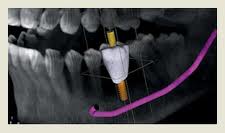 In our Western NC periodontal dental office, we incorporate our care with the advantages of some of the most advanced technology in dentistry; many options which are not readily available in other dental offices in our region. These computerized images offer advantages to patients in helping to minimize treatment needs.
In our Western NC periodontal dental office, we incorporate our care with the advantages of some of the most advanced technology in dentistry; many options which are not readily available in other dental offices in our region. These computerized images offer advantages to patients in helping to minimize treatment needs.
These include:
- LANAP (Laser-Assisted New Attachment Procedure) with PerioLase MVP 7 – an advanced protocol that efficiently and effectively treats advanced gum disease with the added advantages of a dental laser. This offers a non-surgical alternative for patients with moderate to severe periodontal disease and has even been found to stimulate bone regrowth in damaged areas.
- Cone Beam Imaging – is ideal for diagnoses and treatment planning through images that provide a clear view of the upper and lower jaw (including nerve canals), with rotations that show sagittal, axial, and coronal planes in a process that is quick, painless and at minimal radiation levels.
- CareStream Cone Beam Computer Tomography Imaging – is enhanced tomography that works with 3D imaging for exceptional detail and range.
- CS 3600 Intraoral Scanner – quickly and comfortably captures digital impressions to create precision models or appliances accurately and easily (crowns, inlays, onlays, bridges, orthodontic appliances, aligners, custom abutments) without the need for bulky, goopy trays.
- Computerized Dental Implant Placement – an advanced system for pre-surgical positioning of dental implants using a 3D model of the patient’s jaw. Once the implant type is selected, a template is developed for optimal treatment success.
For optimal comfort, we offer several sedation options, including oral and IV sedation. Oral sedation is a pill that helps patients relax. It also has an amnesiac effect, leaving most with little or no memory of treatment afterward. I.V. sedation (also known as “twilight sleep”) places the patient in a deeper sleep state and erases memory of the procedure. It is administered by a doctor of anesthesiology for optimal comfort and safety.
In our Western NC periodontal dental office, anesthesia is overseen by a Medical Doctor (MD) who is a board certified Anesthesiologist. With both sedation options, patients are closely monitored with advanced safety equipment throughout treatment.
Our goal is to help people move forward with treatment affordably for enhanced appearance, self-confidence and sense of security.
For those who have bypassed dental implants because of cost, our payment plans are often able to help patients enjoy the benefits of their dental implants without straining their budget. Most of these payment plans require no down payment, are interest-free, and have no prepayment penalty.
If you’ve considered dental implants in the past but have held back because of obstacles that may actually be overcome, begin by calling our Asheville periodontal dental office and speaking to our friendly staff at: 828-274-9440. Many dental implant patients find they were able to achieve the healthy smile they desired once they consulted with us and learned the options based upon their individual needs.
Achieve Smile Goals With A Periodontist
Posted on Dec 11, 2023 by William J. Claiborne, DDS MS
If you’re like me, I’m usually looking at the end of each year feeling like there are several things I wanted to accomplish for the year, but kept putting them off until I ran out of time.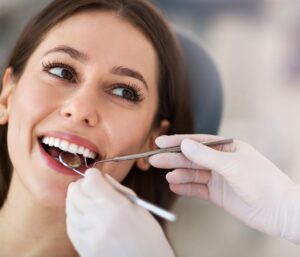
For some people, their oral health and appearance goals are on this list, with some who keep moving the goals to the next year and the next. These goals may include:
• Improving the appearance of a smile
• Having a “cleaner” mouth with fresh breath, etc.
• Replacing missing teeth
• Getting past fear or anxiety of dental visits
If you have one of these on your list, you may be surprised that a periodontal specialist can play a major role in helping you achieve your goals. And, because of the advanced skill level of a periodontist, your comfort, time in treatment and overall results can make the process easier for you.
Many general dentists and other dental specialists refer their patients to a for their specific skills. A periodontist is a dental specialist who is the expert in caring for the gum tissues in your mouth and in the placement of dental implants.
The majority of patients arrive because of periodontal (gum) disease. Common symptoms are red, swollen and tender gums. It often causes gum that bleed easily (often noticed when brushing teeth) and persistent bad breath.
Gum disease (sometimes referred to as ‘perio’ disease) only worsens without treatment. It is the leading cause of adult tooth loss. Additionally, it has been linked to the development or worsening of a long list of serious health problems elsewhere in the body.
Because the inflammatory bacteria disease can enter the bloodstream through diseased gums, their presence can activate conditions that are seemingly unrelated to oral health. Yet, the connection is severe. These health problems include stroke, heart attack, Alzheimer’s disease, dementia, preterm babies, some cancers, arthritis, diabetes, and erectile dysfunction (ED).
In our Asheville periodontal dental office, we are able to treat all stages of gum disease to restore your oral health and minimize the risk of tooth loss. For those who have developed gum disease because they’ve been afraid of dental visits, we offer oral and IV sedation (“twilight sleep”).
Sedation is administered safely by a doctor in anesthesia who uses advanced safety equipment. Our priority is always patient comfort with their safety equally so.
Too, our advanced technology is able to minimize treatment time with amazing results. For example, LANAP (Laser-Assisted New Attachment Procedure) combined with PERIOLASE MVP-7 is designed to efficiently and effectively treat periodontitis (advanced gum disease) with the advantages of a dental laser. This offers non-surgical treatment for patients with moderate to severe periodontal disease. LANAP treatment minimizes discomfort and has a quick recovery time. It has also been found to stimulate bone regrowth in damaged areas.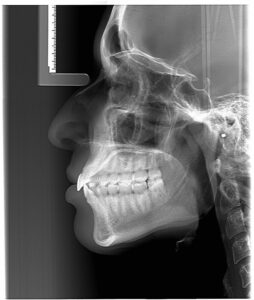
When tooth loss has occurred (whether from gum disease, an accident, or due to genetics), our NW NC dental specialty office also works with a number of dentists in the diagnosis and placement of dental implants.
With over 40 different implant systems, the one suited best for you depends on factors that an experienced dentist must take into consideration. For example, the number of implants you need and how much jaw bone mass exists.
For individuals who have lost a great deal of bone, specific implant types may be recommended. Some, like the “All On 4” implant system, uses specially designed implants which are placed at specific angles.
Bone loss can also be overcome by incorporating a bone rebuilding process into treatment. This is done prior to implant placement and does not require a bone graft. In many cases, we can apply a bone rebuilding material that restores ample bone mass.
The same is true when the sinus cavity will be too close to the proximity. This can be remedied through a “sinus lift.” We provide complete services of these procedures as well as dental implant placement – all performed with advanced skills and technology, such as our Cone Beam 3D imaging.
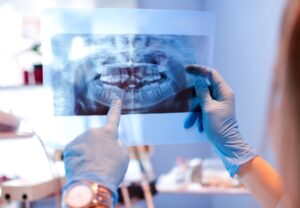 These images are ideal in diagnosis and treatment planning by giving a clear view of the mandible and maxilla (upper and lower jaw). Cone beam radiographs provide images in sagittal, axial, and coronal planes. This makes it possible to locate and trace the mandibular nerve canal for pre-surgical planning for an ideal implant position. Patients are exposed to only minute levels of radiation through a process that is fast and comfortable.
These images are ideal in diagnosis and treatment planning by giving a clear view of the mandible and maxilla (upper and lower jaw). Cone beam radiographs provide images in sagittal, axial, and coronal planes. This makes it possible to locate and trace the mandibular nerve canal for pre-surgical planning for an ideal implant position. Patients are exposed to only minute levels of radiation through a process that is fast and comfortable.
When the enhanced appearance of a smile is being sought, a periodontist also plays a part in helping to create a balanced smile line. In the procedure known as “crown lengthening,” the arch of gum tissues over teeth visible in a smile can be repositioned. This is done in a procedure known as a gingivectomy.
A gingivectomy is also performed to repair a “gummy smile.” This is when too much gum tissue shows above the teeth most visible in a smile. While the condition is not detrimental to oral health, some individuals seek to have it corrected by a periodontist.
Get the coming year started with your smile goals achieved! Call our Asheville periodontal dental office to schedule a consultation. Our friendly staff can help you arrange this private time together by calling 828-274-9440.
Recent Posts
Categories
Archives
- September 2024
- August 2024
- July 2024
- June 2024
- May 2024
- April 2024
- March 2024
- February 2024
- January 2024
- December 2023
- November 2023
- October 2023
- September 2023
- August 2023
- July 2023
- June 2023
- May 2023
- April 2023
- March 2023
- February 2023
- January 2023
- December 2022
- November 2022
- October 2022
- September 2022
- August 2022
- July 2022
- June 2022
- May 2022
- April 2022
- March 2022
- February 2022
- January 2022
- December 2021
- November 2021
- October 2021
- September 2021
- August 2021
- July 2021
- June 2021
- May 2021
- April 2021
- March 2021
- February 2021
- January 2021
- December 2020
- November 2020
- October 2020
- September 2020
- August 2020
- July 2020
- June 2020
- May 2020
- April 2020
- March 2020
- February 2020
- January 2020
- December 2019
- November 2019
- October 2019
- September 2019
- August 2019
- July 2019
- June 2019
- May 2019
- April 2019
- March 2019
- February 2019
- January 2019
- December 2018
- November 2018
- October 2018
- September 2018
- August 2018
- July 2018
- June 2018
- May 2018
- April 2018
- March 2018
- February 2018
- January 2018
- December 2017
- November 2017
- October 2017
- September 2017
- August 2017
- July 2017
- June 2017
- May 2017
- April 2017
- March 2017
- February 2017
- January 2017
- December 2016
- November 2016
- October 2016
- September 2016
- August 2016
- July 2016
- June 2016
- May 2016
- April 2016
- March 2016
- February 2016
- January 2016
- December 2015
- November 2015
- October 2015
- September 2015
- August 2015
- July 2015
- June 2015
- May 2015
- April 2015
- March 2015
- February 2015
- January 2015
- December 2014
- November 2014
- October 2014
- September 2014
- August 2014
- July 2014
- June 2014
- May 2014
- April 2014
- March 2014
- February 2014
- January 2014
- December 2013
- November 2013
- October 2013
- September 2013
- August 2013
- July 2013
- June 2013
- May 2013
- April 2013
- March 2013
- February 2013
- January 2013
- December 2012
- November 2012
- October 2012
- September 2012
- August 2012
- July 2012
- June 2012


